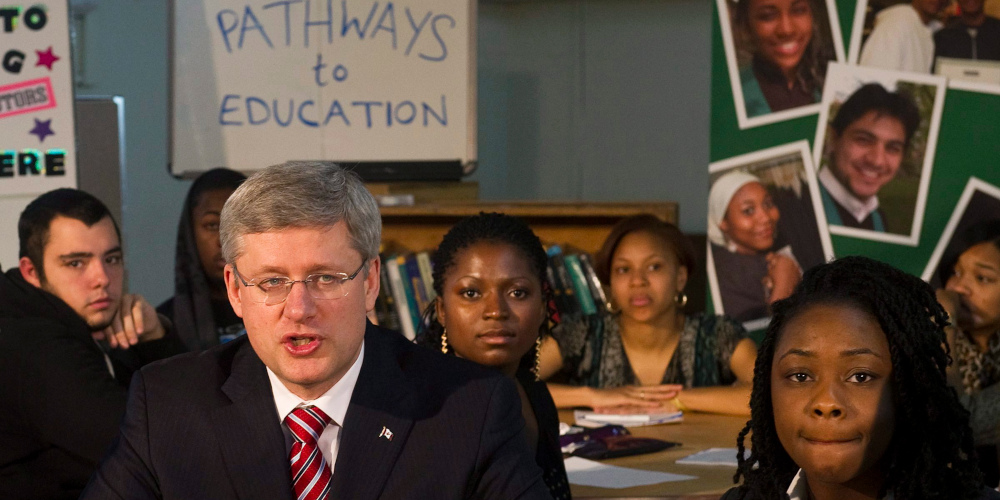In 2007, a consulting firm published an astonishing report. The report concluded that a nonprofit organization called Pathways to Education was responsible for reducing high school dropout rates by 40 percentage points in Toronto’s Regent Park neighbourhood. Such an enormous improvement would be almost unprecedented in evaluations of other similar programs in North America.
As academic economists, we are generally skeptical people. When we came across this report, our first instinct was that the results were too good to be true. The methods also seemed dubious to us. The report compared students who participated in the non-profit’s programming to students in the same neighbourhood who did not participate, not accounting for the fact that more motivated students may be more likely to participate in the programming. It also didn’t account for the fact that high school graduation rates were rising across the City of Toronto during the 1990s and 2000s.
Given these shortcomings, we decided to conduct our own research into the effectiveness of Pathways’ program. We started the project expecting to nullify the consulting firm’s findings. What we found instead was a remarkable success story.

Before telling that story, we should quickly describe the program. Pathways is a non-profit organization that began operating in 2001 in the Regent Park community in Toronto. Over the years, Pathways expanded to 31 communities across the country. It aims to improve the lives of adolescents living in poverty through a comprehensive set of services. The program is organized through four complementary pillars: tailored student social supports, tutoring, mentoring, and financial support. Youth are guided through the program by support workers who they meet with regularly to discuss academic progress, home life, well-being, and any challenges they may be facing. They also meet regularly with academic tutors and volunteer mentors.
To evaluate whether Pathways was actually succeeding in altering the life trajectories of young people, we compared the outcomes of adolescents eligible for the program to a comparison group of similar students who were not eligible, before and after Pathways was introduced in Regent Park.
Using this approach, we found that high school graduation and post-secondary enrollment rates increased dramatically for Pathways-eligible students. We also found that eligibility for Pathways increased their annual earnings by 19 percent, employment rates by 14 percent, and decreased social assistance receipt by more than 30 percent. In a new research paper released last month, we find that eligibility for the Pathways program in Regent Park reduced the likelihood a person was charged with a crime by 32 percent.
It is not just the youth participating in Pathways’ program who benefit from it. Society as a whole benefits from a more educated and productive workforce, from needing to make fewer social assistance payments, and from less crime. We estimate the increased tax revenue from the improvement to labour market outcomes alone outweigh the direct operating costs of Pathways. Accounting for potential improvements to health and reduced expenditures in the criminal justice system and social assistance would further enhance the social return of the program.

We think there are three implications for the Pathways Program.
First, the program is cost-effective in the sense that it generates a high return. If the effects we are finding for Regent Park are the same for other sites (this is our best guess, but for full certainty, the study would have to be replicated for other sites), then an easy case can be made to expand Pathways to other at-risk communities across Canada.
Second, while the Pathways program we evaluated “pays for itself” in terms of long-run increased tax revenue, lower crime costs, and lower transfer payments, there is a significant time lag between when the up-front investment in the program needs to be made and when the returns are realized. This time difference is measured in decades, not years. Since there are few civil society organizations with investment horizons that span a generation or more, we believe there is a role for government to play in investing in programs like Pathways that generate large societal benefits.
Finally, we believe Pathways is better as a nimble grassroots effort rather than as a government-designed and delivered program. As Pathways expands across Canada, it must strike the right balance between delivering a program that has been shown to generate benefits and responding to the local needs of the communities it operates in. Our view is that this flexibility is better achieved through investment in grassroots non-profit organizations like Pathways Canada rather than the creation of new federal programs.
But we wouldn’t be academics if we didn’t say more research needs to be done to help ensure this good news story is actually going on at all locations, and also investigate whether improvements can be made. While we now understand the positive effects of Pathways at its Regent Park location, more research is needed to evaluate whether the Pathways model has been successful in the 30 other communities it now operates in and how it can be improved or costs reduced.
Furthermore, future research should attempt to understand the relative importance of the different features of the Pathways program in generating these positive effects. In particular, this research should attempt to discern whether one or more features of the program (e.g. tutoring, mentoring, or financial supports) primarily drive its long-run impacts or whether the four pillars of the program interact to generate impacts.
If researchers can answer these questions well, the success of the program that began in Regent Park could expand to help even more at-risk youth.
Recommended for You

‘Our role is to ask uncomfortable questions’: The Full Press on why transgender issues are the third rail of Canadian journalism

Michael Kaumeyer: Polite decline: Canada’s aversion to being our best is holding us back

Howard Anglin: Lament for a Lament

‘A place where anybody, from anywhere, can do anything’: The Hub celebrates Canada Day



